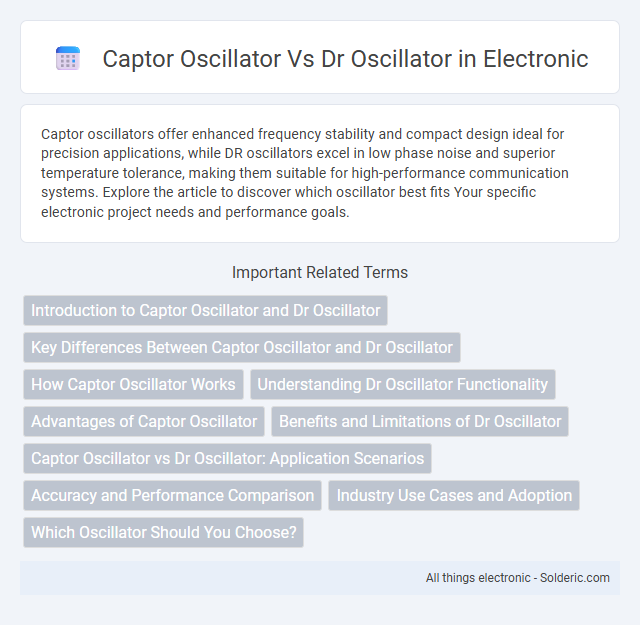Captor oscillators offer enhanced frequency stability and compact design ideal for precision applications, while DR oscillators excel in low phase noise and superior temperature tolerance, making them suitable for high-performance communication systems. Explore the article to discover which oscillator best fits Your specific electronic project needs and performance goals.
Comparison Table
| Feature | Captor Oscillator | DR Oscillator |
|---|---|---|
| Function | Generates stable frequency signals using a quartz crystal | Detects momentum and trend strength in price action |
| Primary Use | Frequency stabilization in electronic circuits | Technical analysis in trading to identify trend reversals |
| Signal Type | Electrical frequency waveforms | Price momentum indicator values |
| Output | Consistent oscillating waveform | Oscillation between overbought and oversold zones |
| Application | Communications, clock generation, signal processing | Stock, forex, and crypto market analysis |
| Measurement | Frequency in Hertz (Hz) | Oscillator value on a numerical scale (usually 0-100) |
Introduction to Captor Oscillator and Dr Oscillator
Captor Oscillators utilize capacitive sensing to detect changes in environmental conditions by measuring variations in capacitance, providing highly sensitive and accurate voltage control. Dr Oscillators operate based on the principles of relaxation oscillation, generating periodic waveforms through controlled charging and discharging cycles of a timing component. Understanding the fundamental differences in sensing and signal generation mechanisms allows you to select the appropriate oscillator type for your specific electronic applications.
Key Differences Between Captor Oscillator and Dr Oscillator
Captor oscillators utilize a voltage-controlled mechanism primarily designed for frequency modulation in communication devices, whereas Dr oscillators often rely on current-controlled components aimed at precision timing applications. The key distinction lies in their control parameters: Captor oscillators respond to voltage variations influencing their oscillation frequency, while Dr oscillators adjust frequency based on current changes. This difference impacts their usage scenarios, with Captor oscillators favoring adjustable frequency sources and Dr oscillators excelling in stable, high-accuracy timing circuits.
How Captor Oscillator Works
Captor oscillators generate stable signals by using a feedback loop where an amplifier and a frequency-selective component, like a crystal or LC circuit, maintain oscillation at a specific frequency. This feedback ensures that the phase shift around the loop is a multiple of 360 degrees and the loop gain equals one, sustaining continuous wave generation. The precision of the frequency is determined primarily by the resonator element, enabling high stability and low phase noise compared to other oscillator types such as discrete resistor (DR) oscillators.
Understanding Dr Oscillator Functionality
Dr oscillators generate signals based on a differential resonant circuit, producing highly stable waveforms essential for precise frequency control. The design improves noise immunity and reduces signal distortion, making it ideal for sensitive electronic applications. Understanding this functionality helps you choose the right oscillator type for your system's stability and performance needs.
Advantages of Captor Oscillator
Captor oscillators offer superior frequency stability and reduced phase noise compared to DR oscillators, enhancing signal integrity in high-precision applications. Their advanced design minimizes temperature sensitivity and power consumption, making them ideal for modern wireless communication systems. Enhanced spectral purity and faster startup times further position captor oscillators as the preferred choice for demanding RF circuits.
Benefits and Limitations of Dr Oscillator
DR oscillator offers superior stability and accuracy in frequency generation compared to traditional captor oscillators, benefiting precision applications such as communications and instrumentation. It provides low phase noise and enhanced temperature stability, which improves overall system performance but can be more complex and costly to implement. Limited tuning range and higher power consumption are notable drawbacks when compared to simpler captor oscillators, impacting its use in low-power or broadly tunable devices.
Captor Oscillator vs Dr Oscillator: Application Scenarios
Captor Oscillators excel in precision frequency generation for telecommunications and signal processing applications, ensuring stable and accurate clock signals in wireless devices. DR Oscillators are typically used in environments requiring low power consumption and portability, such as wearable electronics and IoT sensors, where battery life and compact design are critical. Selecting between Captor and DR Oscillators depends on the balance between frequency stability, power efficiency, and device integration requirements in specific application scenarios.
Accuracy and Performance Comparison
Captor oscillators deliver superior accuracy by maintaining stable frequency output with minimal drift, essential for precise timing applications. DR oscillators offer enhanced performance in environments with fluctuating temperatures due to their adaptive tuning capabilities. Your choice depends on whether consistent accuracy or adaptive performance is critical for your specific application.
Industry Use Cases and Adoption
Captor oscillators dominate the telecommunications and wireless industries due to their superior frequency stability and low phase noise, making them ideal for high-precision signal generation in 5G networks and radar systems. DR oscillators, favored in aerospace and defense sectors, excel in harsh environments with high vibration and temperature fluctuations, enabling reliable operation in avionics and satellite communication. Both oscillator types find adoption in industrial automation and test equipment, with Captor oscillators preferred for signal integrity and DR oscillators for robustness under extreme conditions.
Which Oscillator Should You Choose?
Choosing between a Captor oscillator and a DR oscillator depends on your specific needs for signal stability and noise performance. Captor oscillators offer superior frequency stability and low phase noise, making them ideal for precision applications such as radar and communication systems. Your decision should factor in the required frequency accuracy, environmental conditions, and power consumption to select the oscillator that best optimizes your system's performance.
captor oscillator vs dr oscillator Infographic

 solderic.com
solderic.com